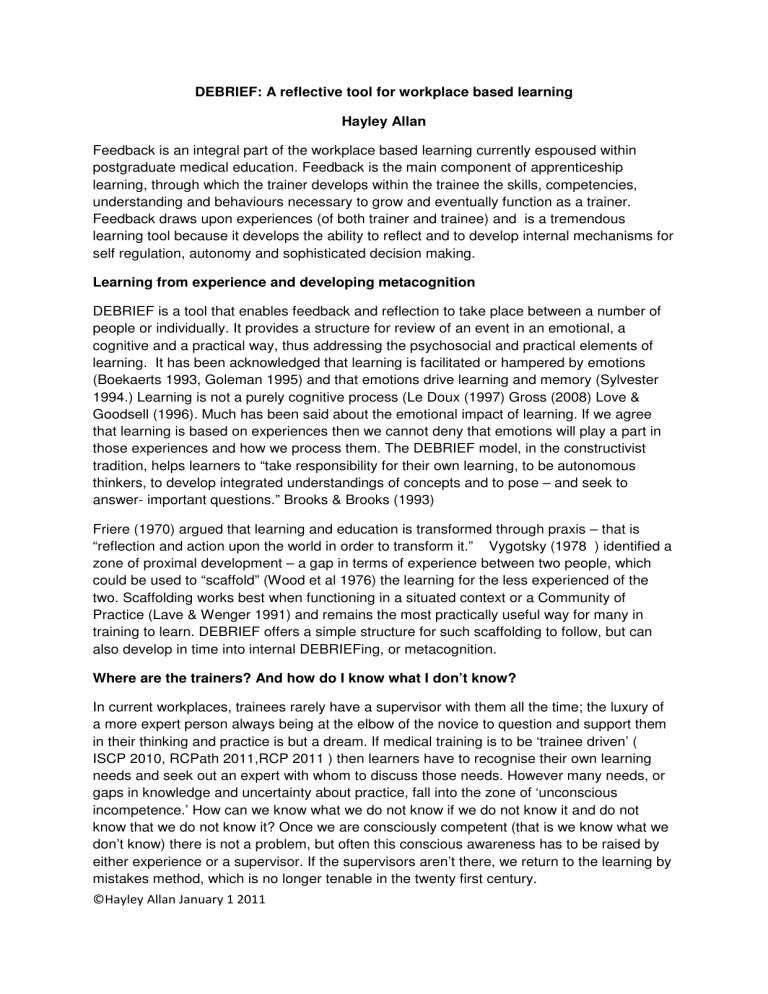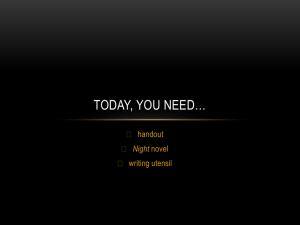DEBRIEF - A reflective tool for workplace based learning

DEBRIEF: A reflective tool for workplace based learning
Hayley Allan
Feedback is an integral part of the workplace based learning currently espoused within postgraduate medical education. Feedback is the main component of apprenticeship learning, through which the trainer develops within the trainee the skills, competencies, understanding and behaviours necessary to grow and eventually function as a trainer.
Feedback draws upon experiences (of both trainer and trainee) and is a tremendous learning tool because it develops the ability to reflect and to develop internal mechanisms for self regulation, autonomy and sophisticated decision making.
Learning from experience and developing metacognition
DEBRIEF is a tool that enables feedback and reflection to take place between a number of people or individually. It provides a structure for review of an event in an emotional, a cognitive and a practical way, thus addressing the psychosocial and practical elements of learning. It has been acknowledged that learning is facilitated or hampered by emotions
(Boekaerts 1993, Goleman 1995) and that emotions drive learning and memory (Sylvester
1994.) Learning is not a purely cognitive process (Le Doux (1997) Gross (2008) Love &
Goodsell (1996). Much has been said about the emotional impact of learning. If we agree that learning is based on experiences then we cannot deny that emotions will play a part in those experiences and how we process them. The DEBRIEF model, in the constructivist tradition, helps learners to “take responsibility for their own learning, to be autonomous thinkers, to develop integrated understandings of concepts and to pose – and seek to answer- important questions.” Brooks & Brooks (1993)
Friere (1970) argued that learning and education is transformed through praxis – that is
“reflection and action upon the world in order to transform it.” Vygotsky (1978 ) identified a zone of proximal development – a gap in terms of experience between two people, which could be used to “scaffold” (Wood et al 1976) the learning for the less experienced of the two. Scaffolding works best when functioning in a situated context or a Community of
Practice (Lave & Wenger 1991) and remains the most practically useful way for many in training to learn. DEBRIEF offers a simple structure for such scaffolding to follow, but can also develop in time into internal DEBRIEFing, or metacognition.
Where are the trainers? And how do I know what I don’t know?
In current workplaces, trainees rarely have a supervisor with them all the time; the luxury of a more expert person always being at the elbow of the novice to question and support them in their thinking and practice is but a dream. If medical training is to be ‘trainee driven’ (
ISCP 2010, RCPath 2011,RCP 2011 ) then learners have to recognise their own learning needs and seek out an expert with whom to discuss those needs. However many needs, or gaps in knowledge and uncertainty about practice, fall into the zone of ‘unconscious incompetence.’ How can we know what we do not know if we do not know it and do not know that we do not know it? Once we are consciously competent (that is we know what we don’t know) there is not a problem, but often this conscious awareness has to be raised by either experience or a supervisor. If the supervisors aren’t there, we return to the learning by mistakes method, which is no longer tenable in the twenty first century.
©Hayley Allan January 1 2011
This is where gut feeling comes in.
C
O
N
S C/IC C/C
C
I
O
U
S UC/IC UC/C
N
E
S
S C O M P E T E N C E
17
Fig 1. The role of conscious awareness in the development of competence.
There is a halfway house between unconscious incompetence and conscious incompetence where gut feeling resides. It is a small space, barely perceptible to some, but it can be developed given practice and the right conditions. Gut feeling can alert the learner to an inconsistency, or a ‘perturbation’ (Piaget 1954, 1971) and it is then the role of the learner to pursue this. There are several ways to do this, and usually the educational response is to seek out a supervisor or mentor for a conversation such as a Case Based Discussion, or to reflect on the perturbation independently. Both approaches can have limited effect. A CBD may yield a sophisticated level of analysis, resulting in new levels of understanding for trainee and even for the trainer. Often however, the conversation becomes didactic and theoretical and the synthesis between knowledge and application can be lost. Independent reflection is a good habit to develop but if the gut feeling is not explored purposefully and systematically there will be no real development beyond the ever decreasing circles we can be trapped in when trying to work out ‘what went wrong.’
DEBRIEFing
Debriefing is a mixture of reflecting and teaching. Using a framework to discuss the gut feeling with a more experienced colleague can lead to unexpected revelations. Once the framework has been practised several times it may work without another person’s input. If the learner becomes accustomed to following the steps in the model, s/he can uncover information and understanding to which they did not have conscious access previously either with a peer or alone.
©Hayley Allan January 1 2011
DEBRIEF model
D escribe events as factually as possible
E valuate what went well/to change next time
B anish emotions/beliefs/assumptions that cloud judgement and development
R eview and analyse in light of previous experience (pattern recognition)
I dentify lessons learned
E stablish follow up actions
F eedback on actions
©Hayley Allan 2009
Fig 2 DEBRIEF model
How does DEBRIEF work?
DEBRIEF is more than reflection. It is a series of questions asked of the learner which promote recall of the events, evaluation of his or her role in the events, and a psychological review of the impact of the events on the learner’s sense of wellbeing, before addressing the cognitive impact and reviewing the account for previous similarities of behaviour. Often perturbations (Piaget 1954, 1971) occur because we repeat behaviour which is a function of emotional or psychological triggers from past experiences. It is only when trainees can look back in a safe environment, knowing that whilst they may have made mistakes they also had a positive effect on some of the events concerning them, that they are free to own those mistakes. Emotions can block cognitive development and progress and so the examining of the feelings, beliefs, assumptions or motives behind the learner’s actions is often a pivotal point at which the individual unblocks that repetitive behaviour or identifies the gut feeling causing the perturbation. Being able to move onto action planning as a result of the identification of what has been learned is a positive and valuable way for the learner to move on from the event.
How does DEBRIEF differ from regular reflection?
Reflection often follows the Learning cycle of Kolb (1984) but rarely bridges the gap between the action and reflection stages or between reflection and theory stages. Most learners are not able to make those large transitions alone without additional structure.
©Hayley Allan January 1 2011
Fig 3 Kolb’s reflective practice cycle
F
Testing in new situations (4)
E
D
Concrete
Experience (1)
Forming abstract concepts (3)
R
E
Observation &
Reflection (2)
B
I
Fig 4 Kolb’s cycle with DEBRIEF added
DEBRIEF provides a step wise structure to enable the learner to progress through each of
Kolb’s learning points, but looking in turn at the behavioural, psychological and cognitive elements of the practice. By following these steps when reviewing an experience the learner is not only processing the experience itself, but is also developing metacognition which will enable further reflection on future experiences.
Building on Pendleton
Many trainers use Pendleton’s rules in discussing performance with trainees. Pendleton’s central tenets are learner comments preceding trainer’s comments, and positive features preceding developmental areas. This is included in the second step of the DEBRIEF model in order to review the actions taken and behaviour used. Without the emotional and cognitive areas of the experience being looked at too, the feedback can remain formulaic and focused on the surface actions rather than the motives or thinking underlying them.
The impact of DEBRIEF on learning
DEBRIEFing makes learners feel in control of their work; by instigating the process and by learning from an honest DEBRIEF, a trainee can relate to the strengths and areas for development within their practice, can understand the psychological impact of events and is able to access theoretical, emotional and practical developmental strategies to change that
©Hayley Allan January 1 2011
work for the better. Ownership of learning, especially in the workplace is a fundamental driver for progress. DEBRIEFing using this structure is a versatile process. A case Based
Discussion can easily turn into a DEBRIEF session as can using Pendleton’s rules for feedback. A learner can seek out a supervisor, more experienced colleague or a peer and discuss the event using the model outlined here. Alternatively the model can be applied to the event independently, using honest self disclosure to explore the issues and impact.
Conclusion
In a postgraduate medical training world where the pressure upon the trainers to teach has never been greater, but the time for teaching has never been more limited, the DEBRIEF model equips learners to structure and guide their own learning, utilising their supervisors, senior colleagues, peers and their own reflections to make sense of their daily experiences.
Learning by pattern recognition is no longer tenable; smaller numbers of experiences carry greater pressure on trainees to learn and develop. DEBRIEF offers a comprehensive model for them to do this.
Bibliography
Boekaerts M (1993) Being concerned with well being and with learning Educational
Psychologist 32(3) 137 - 151
Brooks JG & Brooks MG (1993) In search of understanding: the case for constructivist classrooms. Alexandria VA, Association for Supervision & Curriculum Development
Friere P (1970). Pedagogy of the oppressed. New York: Continuum
Goleman D (1995) Emotional Intelligence New York Bantam books
Gross M (2008) Emotions and feelings in learning process: Understanding emotional learning experiences of Postgraduate students ESREA Life History & Biography Network conference, Canterbury Christ Church university, UK http://tallinn.academia.edu/MarinGross/Papers/253692/Emotions_and_Feelings_In_Lear ning_Process_Understanding_Emotional_Learning_Experiences_of_Postgraduate_Stud ents
ISCP 2010 https://www.iscp.ac.uk/home/principles_intro.aspx
Lave J, Wenger E (1991). Situated Learning: Legitimate Peripheral Participation.
Cambridge: Cambridge University Press.
Le Doux J (1997) The Emotional Brain: the mysterious underpinnings of emotional life
New York Simon & Schuster
Love PG & Goodsell A (1996) Enhancing Student Learning: Intellectual, Social and
Emotional Integration by Love. ASHE-ERIC Higher Education Report series 95-4,
(Volume 24-4), http://www.ntlf.com/html/lib/bib/95-4dig.htm
Kolb D A (1984) Experiential Learning: Experience as the source of learning and development. Prentice-Hall.
RCP 2011 http://www.jrcptb.org.uk/assessment/Pages/Workplace-Based-
Assessment.aspx
RCPath 2011 http://www.rcpath.org/resources/pdf/definitions_of_assessment_tools__ar.pdf
Pendleton’s Rules http://www.gptraining.net/training/educational_theory/feedback/pendleton.htm
©Hayley Allan January 1 2011
Piaget, Jean . (1954). The Construction of Reality in the Child . Translated by Margeter
Cook. New York: Ballantine.
Piaget, Jean . (1971). Psychology and Epistemology: Towards a Theory of Knowledge .
Translated by Arnold Rosen. New York: The Viking Press.
Sylvester, R.
(1994). How emotions affect learning. Educational Leadership, 52(2), 60-
65.
Vygotsky, L.S
. (1978). Mind and society: The development of higher psychological processes . Cambridge, MA: Harvard University Press.
Wood, D. J., Bruner, J. S., & Ross, G.
(1976). The role of tutoring in problem solving.
Journal of Child Psychiatry and Psychology, 17(2), 89-100.
©Hayley Allan January 1 2011
